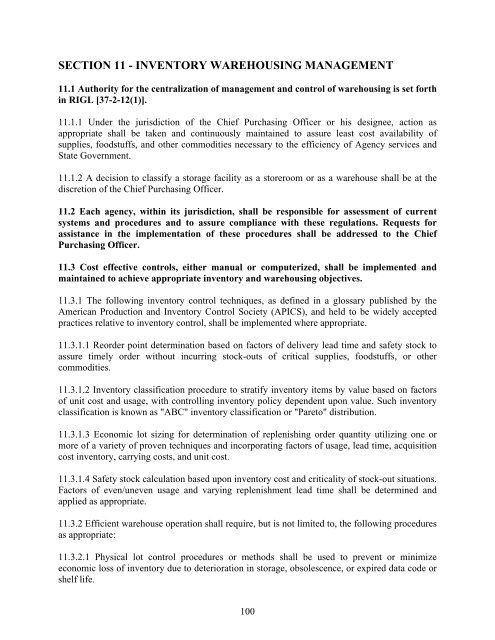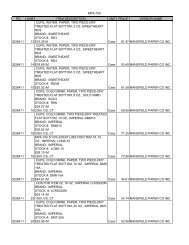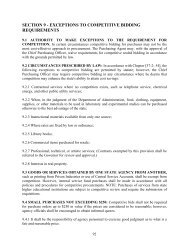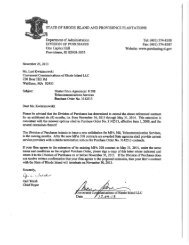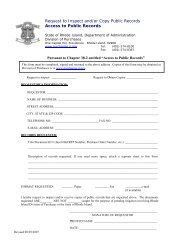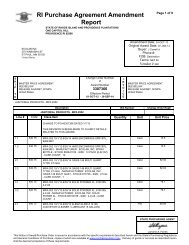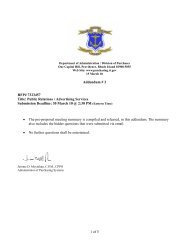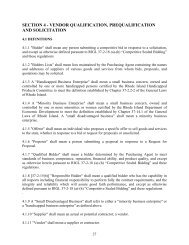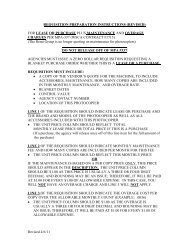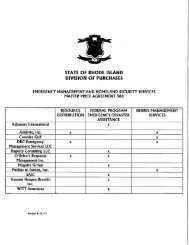SECTION 11 - INVENTORY WAREHOUSING MANAGEMENT
SECTION 11 - INVENTORY WAREHOUSING MANAGEMENT
SECTION 11 - INVENTORY WAREHOUSING MANAGEMENT
Create successful ePaper yourself
Turn your PDF publications into a flip-book with our unique Google optimized e-Paper software.
<strong>SECTION</strong> <strong>11</strong> - <strong>INVENTORY</strong> <strong>WAREHOUSING</strong> <strong>MANAGEMENT</strong><br />
<strong>11</strong>.1 Authority for the centralization of management and control of warehousing is set forth<br />
in RIGL [37-2-12(1)].<br />
<strong>11</strong>.1.1 Under the jurisdiction of the Chief Purchasing Officer or his designee, action as<br />
appropriate shall be taken and continuously maintained to assure least cost availability of<br />
supplies, foodstuffs, and other commodities necessary to the efficiency of Agency services and<br />
State Government.<br />
<strong>11</strong>.1.2 A decision to classify a storage facility as a storeroom or as a warehouse shall be at the<br />
discretion of the Chief Purchasing Officer.<br />
<strong>11</strong>.2 Each agency, within its jurisdiction, shall be responsible for assessment of current<br />
systems and procedures and to assure compliance with these regulations. Requests for<br />
assistance in the implementation of these procedures shall be addressed to the Chief<br />
Purchasing Officer.<br />
<strong>11</strong>.3 Cost effective controls, either manual or computerized, shall be implemented and<br />
maintained to achieve appropriate inventory and warehousing objectives.<br />
<strong>11</strong>.3.1 The following inventory control techniques, as defined in a glossary published by the<br />
American Production and Inventory Control Society (APICS), and held to be widely accepted<br />
practices relative to inventory control, shall be implemented where appropriate.<br />
<strong>11</strong>.3.1.1 Reorder point determination based on factors of delivery lead time and safety stock to<br />
assure timely order without incurring stock-outs of critical supplies, foodstuffs, or other<br />
commodities.<br />
<strong>11</strong>.3.1.2 Inventory classification procedure to stratify inventory items by value based on factors<br />
of unit cost and usage, with controlling inventory policy dependent upon value. Such inventory<br />
classification is known as "ABC" inventory classification or "Pareto" distribution.<br />
<strong>11</strong>.3.1.3 Economic lot sizing for determination of replenishing order quantity utilizing one or<br />
more of a variety of proven techniques and incorporating factors of usage, lead time, acquisition<br />
cost inventory, carrying costs, and unit cost.<br />
<strong>11</strong>.3.1.4 Safety stock calculation based upon inventory cost and criticality of stock-out situations.<br />
Factors of even/uneven usage and varying replenishment lead time shall be determined and<br />
applied as appropriate.<br />
<strong>11</strong>.3.2 Efficient warehouse operation shall require, but is not limited to, the following procedures<br />
as appropriate:<br />
<strong>11</strong>.3.2.1 Physical lot control procedures or methods shall be used to prevent or minimize<br />
economic loss of inventory due to deterioration in storage, obsolescence, or expired data code or<br />
shelf life.<br />
100
<strong>11</strong>.3.2.2 Cycle counting of inventory or periodic physical inventories as prescribed shall be taken<br />
to reconcile inventory balances and assure highest inventory accuracy.<br />
<strong>11</strong>.3.2.3 Inventory Accuracy objectives shall be established based upon inventory stratification<br />
by value (ABC analysis) and accuracy levels. These shall be published and monitored. Any<br />
required corrective action as a result of these procedures shall be taken by appropriate<br />
supervisory personnel.<br />
<strong>11</strong>.3.2.4 Inventory location systems as appropriate shall be implemented to maximize space<br />
utilization and efficiency of order picking, inventory accessibility, and prevention of accidental<br />
injury.<br />
<strong>11</strong>.3.2.5 Safety rules shall be developed, communicated and enforced to prevent accidental injury<br />
due to improper operation of material handling equipment, to ensure routine use of personal<br />
safety equipment, and to preclude other breach of safety rules.<br />
<strong>11</strong>.3.2.6 Housekeeping and general warehouse cleanliness shall be maintained to a high standard.<br />
<strong>11</strong>.3.2.7 Security of warehouse facilities shall be of a quality to prevent loss of inventory due to<br />
theft or pilferage, or damage or destruction to facility due to fire or other external causes<br />
resulting from failure to properly secure the facility.<br />
<strong>11</strong>.4 At any time, the Chief Purchasing Officer may direct or require reports, presentations, or<br />
field audits to measure levels of compliance and shall direct correction of deficiencies<br />
discovered.<br />
<strong>11</strong>.5 As required under routine established procedure or as directed by the Chief Purchasing<br />
Officer or his designee, user agencies of supplies, foodstuffs and other warehoused commodities<br />
shall prepare periodic forecasts of requirements to identify and report upward or downward shifts<br />
in projected usage, thereby mitigating inventory surpluses or shortages resulting from inventory<br />
replenishment decisions or techniques based solely on historical usage.<br />
101


